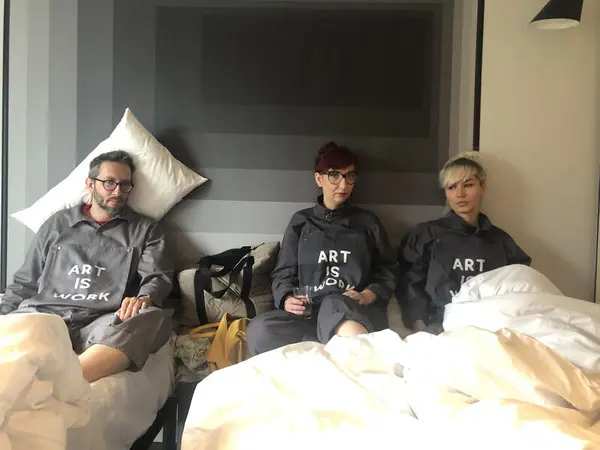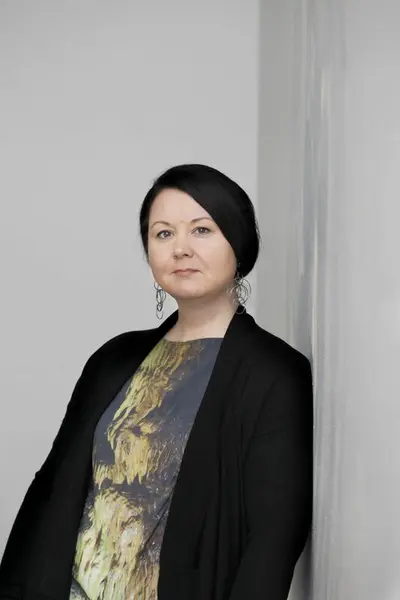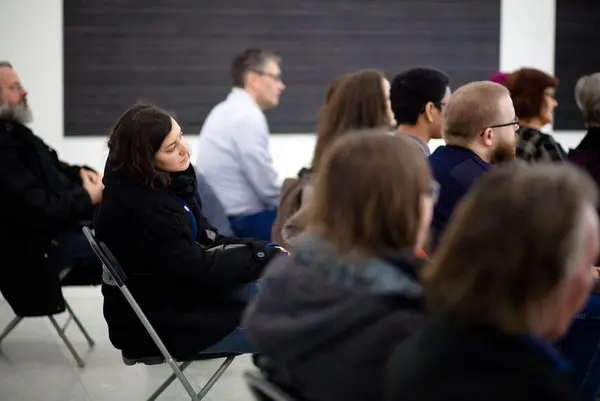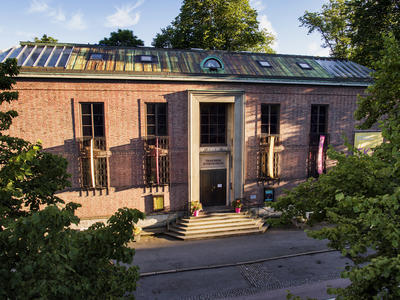I en tid hvor så mye av fortiden og historien stilles spørsmål ved, er det verdt å reflektere rundt språket og begrepene vi bruker, og spørre oss selv: trenger vi et nytt vokabular for fremtidens museum?
Hvilke ord beskriver fremtidens museum?
Trondheim kunstmuseum er i startfasen av en prosess med mulig relokalisering og sammenslåing med Nordenfjeldske Kunstindustrimuseum. I sammenheng med dette, benytter museet muligheten til å se på rollene og forventningene som former relasjonen mellom institusjonen og dens publikum. Utgangspunktet for seminaret er et ønske om å igangsette en forestilling av et nytt vokabular for fremtidens museum, et vokabular som tilpasser seg både institusjonens og det brede publikummets behov.
Velkommen til en kollektiv diskusjon og idemyldring - åpent for alle!
Program 25. - 26. november:
Torsdag 25. November
13.00 - 13.15
Johan Börjesson, direktør Trondheim kunstmuseum, ønsker velkommen
13.15 - 14.00
E for Endospore av Sebastian Cichocki
14.00 - 14.45
N for Network av Steffen Wellinger
15.00 - 15.45
Active Residues av Ofri Cnaani
16.30 - 17.30
S for Suprainfinit WORSKHOP/LECTURE PERFORMANCE av Apparatus 22
Fredag 26. November
09.30 - 10.00
Introduksjon av Marianne Zamecznik, kurator ved Trondheim kunstmuseum
10.00 - 10.45
The Museum of Prefixes: Learning from the Worst-case Scenario av Rasmus Holmboe
11.00 - 11.45
Not-knowing, Rethinking the art museum from pillar to mold av Signe Meisner Christensen
12.00 - 12.30
Oppsummering av Kati Kivinen
Museum Why? E for Endospore
Måter å arbeide på i et kunstmuseum i klimakrisens tid av kurator, skribent og kunstkritiker Sebastian Cichocki.
Museum Why? N for Network
I sitt foredrag vil Steffen Wellinger spekulere i museenes rolle i det urbane og hvordan den fysiske tilstedeværelsen forholder seg til et flerlaget økosystem av digitale, institusjonelle, økonomiske og politiske nettverk. Hvordan kan fremtidens museale rom utvikle og støtte offentlighet, økologi og samfunnsendringer?
Museum Why? A for After the Museum (or: Afterness) // C for 'From Collection to Collective'
I løpet av seks korte timer i september 2018 brant to århundrer med verdifulle gjenstander i Brasils nasjonalmuseum. I mangel av en systematisk digitaliseringsinnsats ved museet, har kunstneren Ofri Cnaani samlet de digitale restene delt av brukere via blant annet WikiCommons, og en komplett virtuell omvisning, et produkt fra Google Arts & Culture, hvor man enkelt kan besøke det ikke-eksisterende museet.
Museum Why? S for Suprainfinit
WORKSHOP / LECTURE PERFORMANCE
Kunstnergruppen Apparatus 22 vi gi et innblikk i de mange ulike måtene de engasjerer seg i transformasjonsprosesser med museer og andre typer institusjoner: fra Blank Auguri, en serie immaterielle verk som kommer i form av navn og navngivingshandlinger, til POSITIVE TENSION (IN THE AIR) hvor kritikk og fest kolliderer i et sett med spørsmål formulert som svar på en spesifikk institusjonell kontekst, fra ART IS WORK-uniformer til skeive dagdrømmer om verk som skjer utenfor institusjoner eller som en måte å utvide institusjoner på. Alle disse satsingene er gjennomsyret av utopiske perspektiver som strekker seg fra Suprainfinit-universet til Apparat 22.
Museum Why? P for Prefix
Prefiksmuseet: Å lære av worse-case scenario av Rasmus Holmboe
I det siste har den kritiske diskusjonen rundt museer dreid seg rundt begreper som post-representasjon, ikke-eksklusiv, dekolonial, og den alltid tilstedeværende ideen om tenke nytt. Betyr dette at vi bare kan tenke nytt basert på det gamle? Selv om dette kan virke som en reaksjonær tilnærming til arbeide med et nytt vokabular, er det fortsatt mye å lære av tidligere feil. Vi kan bare mislykkes. Og så prøve igjen. Og så mislykkes. Og så prøve igjen.
Museum Why? Not-knowing, Rethinking the art museum from pillar to mold
Kurator Signe Meisner Christensen tilbyr ideen om museet som ikke bare en monteringsanordning, men også som noe plastisk, en som er grunnleggende formbar. Ved å flytte metaforen om museet fra en «søyle» til en «komposisjon» tar hun til orde for at kuratering skal bli et sentralt verktøy i å «rekomponere» museet. Hun vil bruke sitt eget praksisbaserte prosjekt OPEN, et offentlig program ved Kunsten, Museum of Modern Art i Aalborg, som eksempel.
Deltakere:

Sebastian Cichocki
Sebastian Cichocki is the chief curator and head of research at the Museum of Modern Art in Warsaw. Selected exhibitions curated and co-curated by Cichocki at the Museum of Modern Art in Warsaw include: ‘Who Will Write the History of Tears. Artists on Women’s Rights’ (2021), ‘The Penumbral Age. Art in the Time of Planetary Change’ (2020), ‘Never Again. Art against War and Fascism in the 20th and 21st centuries’ (2019). Other recent curatorial projects include ‘The Postartistic Congress’, Sokołowsko (2021), ‘Primary Forms’, exhibition at primary schools around Poland (2021), Bródno Biennale, Warsaw (2018). Cichocki also curated the Polish Pavilion at the 52nd and 54th Venice Biennales of Art (in 2007 with Monika Sosnowska, in 2011 with Yael Bartana). He has curated exhibitions in the form of a novella, radio drama, opera libretto, parade, garden, post-growth residency programme, and performance lectures. Cichocki is one of the founding members of The Consortium for Postartistic Practices and The Office for Postartistic Services. He is a 2018 fellow at the Center for Curatorial Leadership, MoMA, New York..

Steffen Wellinger
Steffen Wellinger is professor in architecture at the Department of architecture and planning at NTNU in Trondheim/Norway. He is interested in the reciprocal relation of sustainability, health and beauty in architecture. His educational activities and research are mainly focused on the public realm and public buildings. Steffen is as well coordinating the NTNU Live Studio where students carry out co-curricular activities such as strategic urban interventions. NTNU Live Studio has in 2015 received the Norwegian Education Award.

Ofri Cnaani
Ofri Cnaani is an artist. She works in time-based media, performances, and installations. Her work appeared at Tate Britain, UK; Metropolitan Museum of Art, NYC; Venice's Architecture Biennale; Inhotim Institute, Brazil; PS1/MoMA, NYC; BMW Guggenheim Lab, NYC; Kunsthalle Wien, Vienna. Cnaani is a PhD researcher and Associate Lecturer at the Visual Cultures Department, Goldsmiths, UoL.

Apparatus 22
Apparatus 22 is a transdisciplinary art collective founded in January 2011 by current members Erika Olea, Maria Farcas, Dragos Olea together with Ioana Nemes (1979 - 2011) in Bucharest, Romania. Beginning with 2015 they are working between Bucharest, Brussels and Suprainfinit (utopian universe). They see themselves as a collective of daydreamers, citizens of many realms, researchers, poetic activists and (failed) futurologists interested in exploring the intricate relationships between economy, politics, gender studies, social movements, religion and fashion in order to understand contemporary society. Queering and touching the imagination of people are at centre of their art practice. Starting with 2015 a major topic of research and reflection for Apparatus 22 is SUPRAINFINIT utopian universe: a world-making attempt to use hope critically in navigating present and future. In their very diverse works - installations, performances, text based-shapes, reality is mixed with fiction and storytelling and all merge with a critical approach drawing knowledge & experience from design, sociology, literature and economics.

Rasmus Holmboe
Rasmus Holmboe is postdoc at the research centre Art as Forum at University of Copenhagen, where he works on a project with the Museum of Contemporary Art in Roskilde under the title The Distributed Art Museum. His work traverses the fields of curating, sound studies, art history, musicology and museology with a strong interest in the social and political infrastructures and institutions of the art world. PhD (2019) with the dissertation The Resonant Museum: Sound, Art and the Politics of Curating.

Signe Meisner Christensen
Signe Meisner Christensen is a curator and art researcher based in Aarhus. She works in-between curating, art-based research, and combines academic and collaborative, transdisciplinary work. Her research, which is often practice-based, focuses on the methods and the experiential formats through which curatorial inquiry articulates itself. She approached curatorial action as a making practice that collaborates to enable ecosystems and shared worlds to grow. She holds a PhD in contemporary curating from Aarhus University and presently teaches at Urban Design and Art and Technology, Aalborg University. Recent publications include co-editing the volume “New Infrastructures, Performative Infrastructures in the Art Field”, special issue of Passepartout.

Kati Kivinen
Kati Kivinen is head curator at Museum of Contemporary Art Kiasma in Helsinki, where she is responsible for the exhibitions, acquisitions and commissions, and research on the museum’s collections. Her recent curatorial projects there include group exhibitions: Mad Love: The Seppo Fränti Collection at Kiasma (2020); Coexistence: Human, Animal and Nature in Kiasma’s Collections, Kiasma, Helsinki (2019); There and Back Again: Contemporary Art from the Baltic Sea Region, Kiasma, Helsinki (2018); and solo exhibitions of Mika Vainio: 50 Hz (2020). She worked as Artistic Director of AV-arkki - The Centre for Finnish Media Art, where she curated a number of screening programs (2009-2010).
- 1/1
A for accessability C for communication C for community H for health N for necessities O for operation P for play P for politics P for product P for presence P for participation R for repository S for surprise T for trust T for thing T for together V for value Z for zzzzz
Museum Why? er et samarbeid mellom Trondheim kunstmusuem, Malmö Art Museum (SE), Nykytaiteen museo Kiasma (FI) Museum of Contemporary Art Kiasma og Kunsten som Forum Forskingscenter (DK). Museum Why er støttet Nordisk Kulturkontakt og Nordisk Kulturfond.


